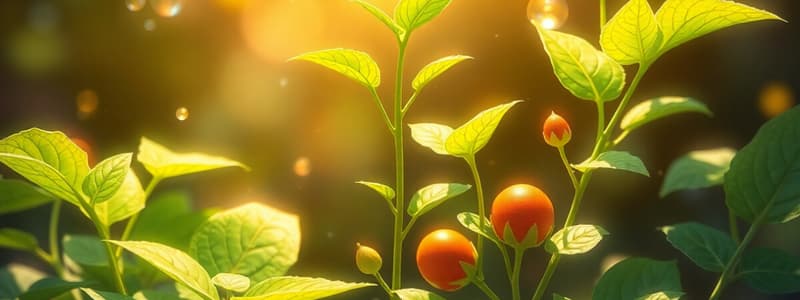Podcast
Questions and Answers
What is the primary function of the digestive system in living organisms?
What is the primary function of the digestive system in living organisms?
- To transport oxygen throughout the body
- To regulate body temperature
- To break down food into nutrients (correct)
- To filter waste products from the blood
Which process is responsible for the exchange of gases in plants?
Which process is responsible for the exchange of gases in plants?
- Diffusion
- Respiration
- Transpiration
- Photosynthesis (correct)
What is the purpose of cellular respiration in living organisms?
What is the purpose of cellular respiration in living organisms?
- To synthesize proteins
- To convert nutrients into energy (correct)
- To produce glucose
- To store genetic information
Which part of the human body primarily absorbs nutrients from digested food?
Which part of the human body primarily absorbs nutrients from digested food?
Which component of the circulatory system is responsible for transporting blood throughout the body?
Which component of the circulatory system is responsible for transporting blood throughout the body?
Flashcards
Life Processes
Life Processes
All the activities that occur within an organism to keep it alive.
Photosynthesis
Photosynthesis
The process by which plants convert light energy into chemical energy.
Respiration
Respiration
The process by which living things obtain energy from food by breaking it down.
Nutrition
Nutrition
Signup and view all the flashcards
Excretion
Excretion
Signup and view all the flashcards
Study Notes
Nutrition in Plants and Animals
- Plants manufacture their own food through photosynthesis, a process using sunlight, carbon dioxide, and water to produce glucose and oxygen.
- Photosynthesis takes place in chloroplasts containing chlorophyll, which absorbs sunlight.
- The equation for photosynthesis is: 6CO₂ + 6H₂O + Light Energy → C₆H₁₂O₆ + 6O₂
- Animals obtain energy from consuming other organisms (heterotrophic nutrition).
- Different modes of animal nutrition include ingestion (eating), digestion (breaking down food), absorption (taking in nutrients), assimilation (using nutrients), and egestion (removing waste).
Types of Nutrition in Plants
- Autotrophic nutrition: Plants make their own food, using raw materials like water, minerals, and carbon dioxide.
- Heterotrophic nutrition: Some plants obtain nutrients from other organisms, such as parasitic plants (e.g., Cuscuta) which obtain nutrients from a host plant. Other plants may be saprophytic, obtaining nutrients from dead and decaying matter.
Nutrition in Animals
- Herbivores eat only plants.
- Carnivores eat only animals.
- Omnivores eat both plants and animals.
- Different animals have adapted digestive systems to suit their diet.
Human Digestive System
- The human digestive system consists of a long tube with associated glands.
- The alimentary canal includes the mouth, esophagus, stomach, small intestine, large intestine, rectum, and anus.
- Accessory glands are salivary glands, liver, and pancreas. These glands secrete digestive juices that aid food breakdown.
Digestion in the Human Body
- Mechanical digestion occurs through chewing and churning in the stomach.
- Chemical digestion involves enzymes that break down food into simpler molecules.
- Salivary amylase begins carbohydrate digestion in the mouth.
- Pepsin in the stomach breaks down proteins.
- Bile from the liver emulsifies fats in the small intestine.
- Pancreatic enzymes (amylase, protease, lipase) further break down carbohydrates, proteins, and fats in the small intestine.
- Absorption of digested food occurs primarily in the small intestine's villi (finger-like projections), which increase the surface area for absorption.
Respiration in Living Organisms
- Respiration is the breakdown of food to release energy.
- Aerobic respiration, requiring oxygen, releases more energy than anaerobic respiration which does not use oxygen.
- Cellular respiration takes place in the mitochondria.
- Equation for aerobic respiration: C₆H₁₂O₆ + 6O₂ → 6CO₂ + 6H₂O + Energy
- In humans, the respiratory system facilitates oxygen intake and carbon dioxide removal. The lungs are the primary organs for gas exchange.
- The diaphragm and intercostal muscles help in breathing.
Importance of Respiration
- Respiration provides energy for body activities like movement, growth, and maintaining body temperature.
Transportation in Plants and Animals
- Plants transport water and minerals from roots to leaves through xylem.
- Plants transport food (prepared in leaves) to other parts of the plant through phloem.
- In animals, the circulatory system transports oxygen, nutrients, hormones, and waste products.
- The human circulatory system includes the heart, blood vessels (arteries, veins, capillaries), and blood.
- Blood carries oxygen to the body cells and removes carbon dioxide.
- Blood also transports nutrients and hormones.
Excretion in Living Organisms
- Excretion is the removal of waste products from the body.
- In plants, waste products like oxygen, carbon dioxide, and water are released through stomata and lenticels.
- In humans, the excretory system includes the kidneys, ureters, bladder, and urethra.
- Kidneys filter blood, producing urine, which is then stored in the bladder and released through the urethra.
Control and Coordination in Animals
- Responses to stimuli are controlled by the nervous system (using nerve impulses).
- The endocrine system uses hormones to regulate body functions.
- The nervous system and endocrine system work together for complex coordination and control in animals.
Control and Coordination in Plants
- Plants respond to stimuli like light, gravity, water, and touch by growing towards or away from the stimulus e.g. Phototropism, geotropism, hydrotropism.
- Plant hormones (auxins) are responsible for coordinated plant growth and responses.
Studying That Suits You
Use AI to generate personalized quizzes and flashcards to suit your learning preferences.




